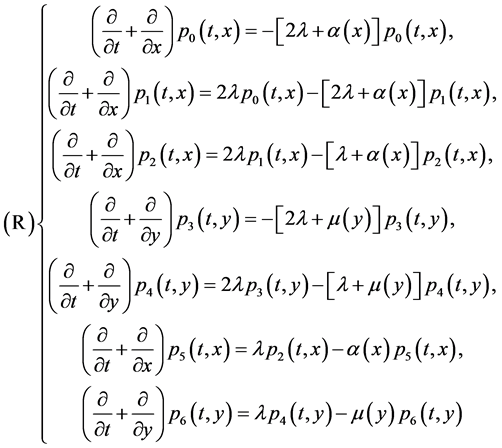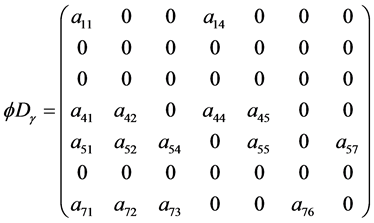Journal of Applied Mathematics and Physics
Vol.03 No.07(2015), Article ID:57662,7 pages
10.4236/jamp.2015.37101
Well-Posedness of Gaver’s Parallel System Attended by a Cold Standby Unit and a Repairman with Multiple Vacations
Abdukerim Haji, Bilikiz Yunus
1College of Mathematics and System Sciences, Xinjiang University, Urumqi 830046, China
2College of Mechanical Engineering, Xinjiang University, Urumqi 830008, China
Email: abdukerimhaji@sina.com.cn, bilikiz62@sina.com.cn


Received 5 May 2015; accepted 23 June 2015; published 30 June 2015

ABSTRACT
We investigate Gaver’s parallel system attended by a cold standby unit and a repairman with multiple vacations. By using C0-semigroup theory of linear operators in the functional analysis, we prove well-posedness and the existence of the unique positive dynamic solution of the system.
Keywords:
Gaver’s Parallel Pystem, C0-Semigroup, Well-Posedness

1. Introduction
The study of repairable systems is an important topic in reliability. The Gaver’s Parallel system is one of the classical repairable systems in reliability. Since the strong practical background of The Gaver’s parallel system, many researchers have studied them extensively under varying assumptions on the failures and repairs, see [1]-[3]. The repairman leaves for a vacation or does other work when there are no failed units for repair in system, which can have important influence to performance of system. In [4], the authors studied Gaver’s parallel system attended by a cold standby unit and a repairman with multiple vacations and obtained some reliability expressions such as the Laplace transform of the reliability, the mean time to the first failure, the availability and the failure frequency of the system. In [4], the authors used the dynamic solution in calculating the availability and the reliability. But they did not discuss the well-posedness and the existence of the positive dynamic solution. Motivated by this, we study in this paper the well-posedness and the existence of a unique positive dynamic solution of the system, by using  -semigroup theory of linear operators. For background reading on semigroup theory we refer to [5] or [6]. First we formulate the model of the system as an abstract Cauchy problem in a Banach space, next we show that the system operator generates a positive contraction
-semigroup theory of linear operators. For background reading on semigroup theory we refer to [5] or [6]. First we formulate the model of the system as an abstract Cauchy problem in a Banach space, next we show that the system operator generates a positive contraction  -semigroup, and finally we prove that the system is well-posed and there is a unique positive dynamic solution.
-semigroup, and finally we prove that the system is well-posed and there is a unique positive dynamic solution.
The Gaver’s parallel system attended by a cold standby unit and a repairman with multiple vacations can be described by the following equations (see [4]).

with the boundary conditions

And the initial conditions
 where
where 
Here ;
;  gives the probability that at time t two units are operating, one unit is under standby, the repairman is in vacation, the system is good and the elapsed repair time lies in
gives the probability that at time t two units are operating, one unit is under standby, the repairman is in vacation, the system is good and the elapsed repair time lies in ;
;  represents the probability that at time
represents the probability that at time  two units are operating, one unit is waiting for repair, the repairman is in vacation, the system is good and the elapsed repair time lies in
two units are operating, one unit is waiting for repair, the repairman is in vacation, the system is good and the elapsed repair time lies in ;
;  represents the probability that at time
represents the probability that at time  two unit is operating, one unit is waiting for repair, the repairman is in vacation, the system is good and the elapsed repair time lies in
two unit is operating, one unit is waiting for repair, the repairman is in vacation, the system is good and the elapsed repair time lies in ;
;  represents the probability that at time two units are operating, one unit being repaired, the system is good and the hours that the failed unit has been repaired lies in
represents the probability that at time two units are operating, one unit being repaired, the system is good and the hours that the failed unit has been repaired lies in ;
; 











Throughout the paper we require the following assumption for the vacation rate function 

General Assumption 1.1: The functions 

2. Problem as an Abstract Cauchy Problem
To apply semigroup theory we transform in this section the system



and

To define the system operator 

where
To model the boundary conditions (BC) we use an abstract approach as in [7]. For this purpose we consider the “boundary space” 


and

where

The system operator 

With these definitions the above equations (R), (BC) and (IC) are equivalent to the abstract Cauchy problem

3. Characteristic Equation
In this section we characterize 




The elements in 
Lemma 3.1: For

Using [8, Lemma 1.2], the domain 


Moreover, since 


and call it “Dirichlet operator”.
We can give the explicit form of 
Lemma 3.2: For each


where
For



where
The Following result, which can be found in [9], plays important role for us to prove the well-posedness of the system.
Lemma 3.3 (The characteristic equation): If 


4. Well-Posedness of the System
Our main goal in this section is to prove the well-posedness and the existence of a unique positive dynamic solution of the system. We first prove that the operator A generates a positive contraction 



Lemma 4.1: If


Proof: Let




Lemma 4.2: 


If 


It is obvious that 
where
Lemma 4.3: The operator 
Proof: For

where 
Noting the boundary condition, it is not difficult to see that

From Lemma 4.1 - 4.3 we see that all the conditions in Phillips’ theorem (see [6], Thm. C-II 1.2]) are fulfilled and thus we obtain the following result.
Theorem 4.4: The operator 


From Theorem 4.4 and [5] (Cor.II.6.9) we can characterize the well-posedness of 
Theorem 4.5: The associated abstract Cauchy problem 
From Theorem 4.5 and [5] (Prop.II.6.2) we can state our main result.
Theorem 4.6: The system 


Acknowledgment
This work was supported by the National Natural Science Foundation of China (No.11361057).
Cite this paper
Abdukerim Haji,Bilikiz Yunus, (2015) Well-Posedness of Gaver’s Parallel System Attended by a Cold Standby Unit and a Repairman with Multiple Vacations. Journal of Applied Mathematics and Physics,03,821-827. doi: 10.4236/jamp.2015.37101
References
- 1. Gaver, D.P. (1963) Time to Failure and Availability of Paralleled System with Repair. IEEE Transactions on Reliability, 12, 30-38. http://dx.doi.org/10.1109/TR.1963.5218202
- 2. Dhillon, B.S. and Anude, O.C. (1993) Common-Cause Failure Analysis of a Parallel System with Warm Standby. Microelectronics Reliability, 33, 1321-1342. http://dx.doi.org/10.1016/0026-2714(93)90133-J
- 3. Vanderperre, E.J. and Makhanov, S.S. (2002) On Gaver’s Parallel System Sustained by a Cold Standby Unit and Attended by Two Repairmen. Operations Research Letters, 30, 43-48. http://dx.doi.org/10.1016/S0167-6377(02)00106-2
- 4. Yue, D.Q., Zhu, J.L., Qin, Y.L. and Li, C.Y. (2006)The Gaver Parallel System Attended by a Cold Standby Unit and a Repairman with Multiple Vacations. Systems Engi-neering-Theory & Practice, 6, 59-68.
- 5. Engel, K.-J. and Nagel, R. (2000) One-Parameter Semigroups for Linear Evolution Equations. Graduate Texts in Mathematics, 194, Springer-Verlag.
- 6. Nagel, R. (1986) One-Parameter Semigroups of Positive Operators. Springer-Verlag. http://dx.doi.org/10.1007/BFb0074922
- 7. Casarino, V., Engel, K.-J., Nagel, R. and Nickel, G. (2003) Asemigroup Approach to Boundary Feedback Systems. Integral Equations and Operator Theory, 47, 289-306. http://dx.doi.org/10.1007/s00020-002-1163-2
- 8. Greiner, G. (1987) Perturbing the Boundary Conditions of a Generator. Houston J. Math., 13, 213-229.
- 9. Haji, A. and Radl, A. (2007) Asemigroup Approach to Queueing Systems. Semigroup Forum, 75, 609-623. http://dx.doi.org/10.1007/s00233-007-0726-6

































